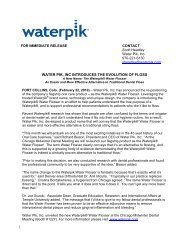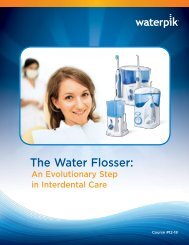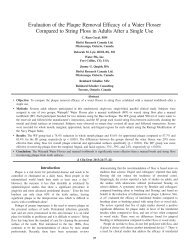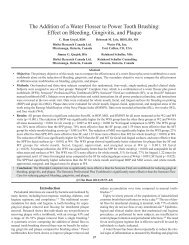Seniors and Boomers: Living Longer, Living Healthier ... - Waterpik
Seniors and Boomers: Living Longer, Living Healthier ... - Waterpik
Seniors and Boomers: Living Longer, Living Healthier ... - Waterpik
You also want an ePaper? Increase the reach of your titles
YUMPU automatically turns print PDFs into web optimized ePapers that Google loves.
two of three oral cancers. These oral cancers seem to occur more<br />
often in the tonsils. People who develop oral cancer due to an<br />
HPV infection are often young, male, <strong>and</strong> less likely to be a heavy<br />
drinker or smoker. People diagnosed with HPV-related oral cancer<br />
seem to have a better prognosis than those with oral cancer<br />
caused by tobacco or alcohol. 22<br />
Dementia: Alzheimer’s Disease<br />
There are numerous types of dementia, the most common being<br />
Alzheimer’s disease, which accounts for about 60–80% of all<br />
dementia cases. With dementia, nerve cells in the brain cease to<br />
function <strong>and</strong> die. This results in changes to memory, behavior, <strong>and</strong><br />
the ability to think clearly. In Alzheimer’s disease, the ability to<br />
remember recent events is often the first sign. Vascular dementia is<br />
the second most common type of dementia, often occurring after<br />
a brain injury such as a stroke. Symptoms for this type of dementia<br />
are more likely to center on impaired judgment or inability to make<br />
plans versus memory loss. Many people have mixed dementia—<br />
both vascular <strong>and</strong> Alzheimer’s. People affected by Parkinson’s<br />
disease may also experience dementia in later stages. 23<br />
Of the 5.4 million people with Alzheimer’s disease, 5.2 million<br />
are over 65. This translates to 1 in 8 or 13% of those 65 <strong>and</strong> over.<br />
Of those over 85, 45% are afflicted. Two-thirds of Alzheimer’s<br />
victims are women. This occurs because women live longer, not<br />
necessarily because they are more susceptible. As the number<br />
of the elderly population increase, it estimated that by 2050 the<br />
incidence of Alzheimer’s <strong>and</strong> dementia will have doubled. 23<br />
Alzheimer’s is believed to be caused by multiple factors. Aging,<br />
family history, presence of CVD risk factors, <strong>and</strong> previous head/<br />
brain trauma have been identified as potential risk factors for<br />
Alzheimer’s. There is some evidence to indicate that controlling<br />
cholesterol <strong>and</strong> blood pressure, managing diabetes, quitting<br />
smoking, losing weight, <strong>and</strong> increasing physical activity may help<br />
in avoiding cognitive decline. 23<br />
Alzheimer’s is the sixth leading cause of death overall, <strong>and</strong> fifth in<br />
those over 65. People with Alzheimer’s live an estimated 4–6 years<br />
once they have been diagnosed, although some live as many as 20<br />
years post-diagnosis. Fifteen million people provide unpaid care<br />
for a family member or friend with Alzheimer’s/dementia. Eighty<br />
percent of this care is provided at home. Almost half of caregivers<br />
are taking care of a parent. Thirty percent of caregivers are also<br />
caring for a child or gr<strong>and</strong>child under age 18. This equates to<br />
about 17 billion hours in unpaid care that would be valued at over<br />
$210 billion. Caregiving takes a toll on the health of the caregiver,<br />
with many experiencing emotional stress, depression, or other<br />
health issues. 23<br />
FUNCTIONAL LIMITATIONS<br />
AND DISABILITIES<br />
Growing evidence indicates that the prevalence of disability<br />
is declining. Earlier detection of disease, better treatments,<br />
<strong>and</strong> access to rehabilitation services have contributed to this<br />
advancement. 2 The ability to delay the onset of disability has<br />
been shown to be a stronger predictor of longevity than staving<br />
off disease. About a third of people living past age 100 have<br />
coped with chronic illness for 15 years or more prior to turning<br />
100. 24 Staving off disability may mean that seniors have greater<br />
opportunity for social interaction. Older women with large social<br />
networks have been shown to have better cognitive function <strong>and</strong><br />
are less likely to be diagnosed with dementia. 25<br />
The ability to delay the onset of disability<br />
is a stronger predictor of longevity than<br />
staving off disease. 24<br />
Disability may be defined as a substantial limitation in a major life<br />
activity. This includes not just the ability to reach, bend, stoop,<br />
st<strong>and</strong>, sit, or lift, but activities of daily living (ADL) including<br />
bathing, eating, toileting, dressing, <strong>and</strong> getting out of bed or a<br />
chair. Individuals may also be considered disabled if they cannot<br />
fix their own meals, do light housework, manage their own money,<br />
<strong>and</strong> use the telephone or shop for personal items (Instrumental<br />
Activities of Daily <strong>Living</strong>). About 14 million people over 70 have<br />
some type of disability. Disability can result from chronic diseases<br />
including diabetes, CVD, COPD, Alzheimer’s, osteoporosis, or<br />
arthritis. Older individuals are also more likely to have vision<br />
or hearing impairments that may decrease their functional<br />
independence. 3<br />
Osteoporosis <strong>and</strong> Hip Fractures<br />
The National Osteoporosis Foundations estimates that about 10<br />
million people in the United States have osteoporosis. Of this<br />
number, 8 million are women. It is estimated that 34 million have<br />
low bone mass. Women can lose up to 20% of their bone mass<br />
in the 5–7 years post-menopause. People often do not even<br />
know they have osteoporosis until they break a bone. Factors<br />
that increase the risk for osteoporosis include advanced age,<br />
low calcium <strong>and</strong> vitamin D intake, an inactive lifestyle, cigarette<br />
smoking, <strong>and</strong> excessive use of alcohol. 26<br />
Table 3: Yearly Osteoporosis-Related Fractures: 26<br />
• 297,000 hip fractures<br />
• 547,000 vertebral fractures<br />
• 397,000 wrist fractures<br />
• 135,000 pelvic fractures<br />
• 675,000 fractures at other sites<br />
Osteoporosis can lead to bone fragility <strong>and</strong> increased risks<br />
for fracture. It is responsible for more than 2 million fractures<br />
yearly (Table 3). It is expected to rise to 3 million by 2025. One<br />
in two women <strong>and</strong> one in four men over 50 will experience an<br />
5













